History of Cornwall
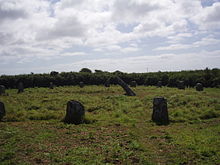
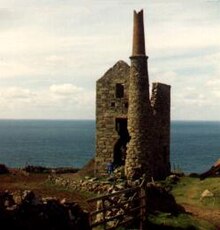

The history of Cornwall begins with the pre-Roman inhabitants, including speakers of a Celtic language that would develop into Brythonic and Cornish. Cornwall was part of the territory of the tribe of the Dumnonii which included modern-day Devon and parts of Somerset. After a period of Roman rule, Cornwall reverted to rule by independent Romano-British princes and continued to have a close relationship with Brittany, and Wales as well as southern Ireland which neighboured across the Celtic Sea. After the collapse of Dumnonia, the remaining territory of Cornwall came into conflict with neighbouring Wessex.
By the time of the Norman Conquest, Cornwall had fallen under the control of the Kingdom of England. In 1337, the title Duke of Cornwall was created by the English monarchy, to be held by the king's eldest son and heir. Cornwall, along with the neighbouring county of Devon, maintained Stannary institutions that granted some local control over its most important product, tin, but by the time of Henry VIII most vestiges of Cornish autonomy had been removed as England became an increasingly centralised state under the Tudors. Conflicts with the centre took place with the Cornish Rebellion of 1497 and Prayer Book Rebellion of 1549. By the 18th century, Cornwall was incorporated into the Kingdom of Great Britain along with the rest of England and the Cornish language had gone into steep decline. The industrial revolution brought huge change to Cornwall, as well as the adoption of methodism among the general populace, turning the area nonconformist. Decline of mining in Cornwall resulted in mass emigration overseas and the Cornish diaspora, as well as the start of the Celtic revival resulting in the beginnings of Cornish nationalism in the late 20th century.
Cornwall's Early Medieval history, in particular the early Welsh and Breton references to a Cornish 'king' named Arthur, have featured in such legendary works as Geoffrey of Monmouth's Historia Regum Britanniae, predating later Arthurian legend (see the list of legendary rulers of Cornwall).
Pre-Roman Cornwall
Late Stone Age
The present human history of Cornwall begins with the reoccupation of Britain after the last Ice Age. The inhabitants may have been related to the Iberians who occupied Spain and Portugal.
The upland areas of Cornwall were the parts first open to settlement as the vegetation required little in the way of clearance: they were perhaps first occupied in Neolithic times (Palaeolithic remains are almost non-existent in Cornwall). Many Megalithic monuments of this period exist in Cornwall and prehistoric remains in general are more numerous in Cornwall than in any other English county except Wiltshire. The remains are of various kinds and include standing stones, barrows and hut circles.[1][2]
Bronze Age
Cornwall and neighbouring Devon had large reserves of tin, which was mined extensively during the Bronze Age by people associated with the Beaker culture. Tin is necessary to make bronze from copper, and by about 1600 BCE the West Country was experiencing a trade boom driven by the export of tin across Europe. This prosperity helped feed the skilfully wrought gold ornaments recovered from Wessex culture sites.
There is evidence of a relatively large scale disruption of cultural practices around the 12th century BCE that some scholars think may indicate an invasion or migration into southern Britain.[citation needed]
Iron Age
Around 750 BCE the Iron Age reached Britain, permitting greater scope of agriculture through the use of new iron ploughs and axes. The building of hill forts also peaked during the British Iron Age. During broadly the same time (900 to 500 BCE), the Celtic culture and peoples spread across the British Isles.
During the British Iron Age Cornwall, like all of Britain south of the Firth of Forth, was inhabited by the Celtic people known as the Britons. The Celtic British language spoken at the time eventually developed into several distinct tongues, including Cornish.[3]
The first account of Cornwall comes from the Sicilian Greek historian Diodorus Siculus (ca. 90 BCE–ca. 30 BCE), supposedly quoting or paraphrasing the 4th-century BCE geographer Pytheas, who had sailed to Britain:
The inhabitants of that part of Britain called Belerion (or Land's End) from their intercourse with foreign merchants, are civilised in their manner of life. They prepare the tin, working very carefully the earth in which it is produced ... Here then the merchants buy the tin from the natives and carry it over to Gaul, and after travelling overland for about thirty days, they finally bring their loads on horses to the mouth of the Rhône.[4]


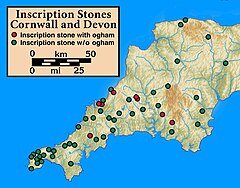
Who these merchants were is not known. Historical sources such as Strabo, though not entirely reliable, state that the Phoenicians traded tin with Cornwall. There is no archaeological evidence for this. Some modern historians have attempted to debunk earlier antiquarian constructions of "the Phoenician legacy of Cornwall",[5][6][7][8] including belief that the Phoenicians even settled Cornwall.
Toponymy
By the time that Classical written sources appear, Cornwall was inhabited by tribes speaking Celtic languages. The ancient Greeks and Romans used the name Belerion or Bolerium for the south-west tip of the island of Britain, but the late-Roman source for the Ravenna Cosmography (compiled about 700 CE) introduces a place-name Puro coronavis, the first part of which seems to be a misspelling of Duro (meaning Fort). This appears to indicate that the tribe of the Cornovii, known from earlier Roman sources as inhabitants of an area centred on modern Shropshire, had by about the 5th century established a power-base in the south-west (perhaps at Tintagel).[9] The tribal name is therefore likely to be the origin of Kernow or later Curnow used for Cornwall in the Cornish language. John Morris suggested that a contingent of the Cornovii was sent to South West Britain at the end of the Roman era, in order to rule the land there and keep out the invading Irish, but this theory was dismissed by Professor Philip Payton in his book Cornwall: A History.[3] The Cornish Cornovii may even be a completely separate tribe, taking their name either from the horn shape of the peninsula, or from the Horned God Cernunnos.
The English name, Cornwall, comes from the Celtic name, to which the Anglo-Saxon word Wealas (Welsh, or foreigners) is added.[10]
Roman Cornwall
During the time of Roman dominance in Britain, Cornwall was rather remote from the main centres of Romanisation. The Roman road system extended into Cornwall, but the only known significant Roman sites are three forts:- Tregear near Nanstallon was discovered in early 1970s, the other two found more recently at Restormel Castle, Lostwithiel (discovered 2007) and a fort near to St Andrew’s Church in Calstock (discovered early in 2007).[11] A Roman style villa was found at Magor Farm near Camborne.[12] Furthermore, the British tin trade had been largely eclipsed by the more convenient supply from Iberia.
Only a few Roman milestones have been found in Cornwall; two have been recovered from around Tintagel in the north (detailed below), one at Mynheer Farm (near the hillfort at Carn Brea), and another two close to St Michael's Mount one of which is preserved at Breage Parish Church. The stone at Tintagel bears an inscription to Imperator Caesar Gaius Valerius Licinius Licinianus, and the other stone at Trethevy, is inscribed to the imperial Caesars, Gallus and Volusianus.[13]
According to Léon Fleuriot, however, Cornwall remained closely integrated with neighbouring territories by well-travelled sea routes. Fleuriot suggests that an overland route connecting Padstow with Fowey and Lostwithiel served, in Roman times, as a convenient conduit for trade between Gaul (especially Armorica) and the western parts of the British Isles.[14]
Archaeological sites at Chysauster and Carn Euny in West Penwith and the Isles of Scilly demonstrate a uniquely Cornish 'courtyard house' architecture built in stone of the Roman period, entirely distinct from that of southern Britain, yet with parallels in Atlantic Ireland, North Britain and the Continent, and influential on the later development of stone-built fortified homesteads known in Cornwall as 'Rounds'.[15]
Post-Roman and Medieval periods
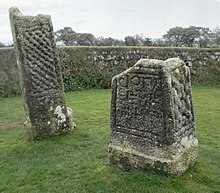
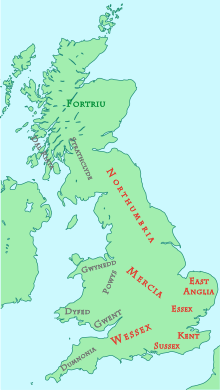

In the wake of the Roman withdrawal from Great Britain generally dated to 410 CE, Saxons and other Germanic peoples were able to conquer and settle most of the east of the island. In the west, however, Cornwall, Wales and the southwest peninsula remained under the influence of local Romano-British and Celtic elites as part of Dumnonia with close cultural contacts with Christian Ireland, Romano-Celtic Brittany and Byzantium via the West Atlantic trade network with exceptional archaeological evidence for Late Antique trading contacts evidenced at stronghold of Tintagel in Trigg in particular.[16]
In Arthurian legend Gorlois (Gwrlais in Welsh) is attributed the title "Duke of Cornwall", but evidence of his existence is scant. Place names such as Carhurles (Caer-Wrlais) and Treworlas (Tre-Wrlais) suggest the possibility of an historic individual. Gottfried von Strassburg's courtly epic Tristan und Isolde (c.1200) was also set in a Kingdom of Cornwall.[citation needed] There was almost certainly a King Mark of Cornwall, aka cunomorus ('sea-hound' (i.e.'shark') who may also have held parallel territory in modern Brittany. After most of the territory of Brythonic Dumnonia was absorbed into Saxon Wessex, the British rulers are referred to as kings of Cornwall (Latin Rex Corniu) or the kings of the "West Welsh" (Saxon Westwealas). Early Welsh romances place the court of Arthur in "Celliwig in Cerniw" (Old Welsh/Old Cornish 'Sacred Grove') - later the court is transferred to Caerleon in South Wales.[17]
Th notorious Artognou stone - a reused Roman military slate drain cover discovered at Tintagel - is significant not least because it evidences a level of everyday literacy in both Latin and Brythonic uncommon in sub-Roman Britain with no parallel in Saxon England.[16]
Relationship with Wessex
As Devon was progressively ceded to dominance by the early English (Anglo Saxon Englisc) kingdom of Wessex, the area west of the River Tamar (present-day Cornwall) gradually became a dependant entity, retaining a separate language and degree of autonomy: its rulers were at first sub-kings [Latin Dux][citation needed] and then successors of the Brythonic Celtic Kingdom of Dumnonia. The political situation was much in flux, and several kings or polities such as Marcus Cunomorus and many of the Celtic Saints, also appear to have exercised sovereignty across the Channel in Brittany.[citation needed]
However, the early kings of Wessex in particular are notable for their prevalence of Brythonic names[18] and therefore care should be exercised in assuming a stark ethnic antipathy between emergent 'British' and 'English' identities and culture; rather a struggle for dominance of warring elites more or less aligned with eastern 'Germanic' and western 'Romano-Celtic' cultures.[19] Atlantic Brythons were often recorded in alliance with Scandinavian forces such as the Danes, or Normans in Brittany, up to the period of the Norman Conquest.[20]
After several battles further east were won by the West Saxons, in 721 or 722 the Britons won the Battle of Hehil (at an unknown location in Devon or Cornwall) probably against them[citation needed]. After this, a century passed before any further battles involving Cornwall are recorded, although the "Welsh" who fought a battle against King Cuthred in 753 were probably from this area.[citation needed]
In 814 King Egbert "raided in Cornwall from east to west",[21][22] and the Anglo-Saxon Chronicle tells us that in 825 (adjusted date) a battle took place at Gafulforda, probably near Lew Trenchard in West Devon: "The West Wealas (Cornish) and the men of Defnas (Devon) fought at Gafulforda".[3][21] In 838 the Cornish in alliance with the Danes were defeated by Egbert of Wessex[21].
In 875, the Annales Cambriae record that king Dungarth of Cerniu ("id est Cornubiae") drowned and by the 880s Wessex had gained control of at least part of Cornwall, where Alfred the Great had estates.[23] William of Malmesbury, writing around 1120, says that King Athelstan of England (924–939) fixed Cornwall's eastern boundary at the River Tamar and the remaining Cornish were evicted from Exeter and perhaps the rest of Devon - "Exeter was cleansed of its defilement by wiping out that filthy race".[3] These British speakers may have been deported across the Tamar, which was fixed as the border of the Cornish; they were left under their own dynasty to regulate themselves with west Welsh tribal law and customs, rather like the Indian princes under the Raj.[24] By 944 Athelstan's successor, Edmund I of England, styled himself 'King of the English and ruler of this province of the Britons',[25] an indication of how that accommodation was understood at the time.
The chronology of English expansion into Cornwall is unclear, but most historians place the end of independence during the reign of Edward the Confessor.[citation needed] The eldest son of the English monarch became Duke of Cornwall in 1337, in succession to the previous Earls of Cornwall.[26][27]
William Camden writing in his book Britannia in 1607 states:
As for those Cornwallians, although they stoutly bent all their force together in defence of their Countrey, yet soone became they subject to the Saxons, as who neither matched then in number, neither was their Countrey sufficiently fenced by nature to defend them.[28]
Cornwall showed a very different type of settlement pattern to that of Saxon Wessex and places continued (even after 1066) to be named in the Celtic Cornish tradition with Saxon architecture being uncommon in Cornwall.[citation needed]. Early medieval settlements of West Devon and Cornwall in the form of dispersed settlements (Cornish Tre) of stone-built longhouses, and circular enclosed settlements (rounds)[29] have closer parallels with those found in Ireland, Wales, Britanny and Northern France than with the timber settlements found in Saxon England.[30]
The Cornish Church
The first centuries after the Romans left are known as the 'age of the saints', as Celtic Christianity and a revival of Celtic art spread from Ireland, Wales and Scotland into Great Britain, Brittany, and beyond. According to tradition the area was evangelized in the 5th and 6th centuries by the children of Brychan Brycheiniog and saints from Ireland. Cornish saints such as Piran, Meriasek, or Geraint exercised a religious and arguably political influence; they were often closely connected to the local civil rulers[citation needed] and in some cases were kings themselves. There was an important monastery at Bodmin and sporadically, Cornish bishops are named in various records.
By the 880s more Saxon priests were being appointed to the Church in Cornwall and they controlled some church estates like Polltun, Caellwic and Landwithan (Pawton, in St Breock; perhaps Celliwig (Kellywick in Egloshayle?); and Lawhitton. Eventually they passed these over to Wessex kings. However according to Alfred the Great's will the amount of land he owned in Cornwall was very small.[23] West of the Tamar Alfred the Great only owned a small area in the Stratton region, plus a few other small estates around Lifton on Cornish soil east of the Tamar). These were provided to him through the Church whose Canterbury appointed priesthood was increasingly English dominated.[citation needed]
The early organisation and affiliations of the Church in Cornwall are unclear, but in the mid-9th century it was led by a Bishop Kenstec with his see at Dinurrin, a location which has sometimes been identified as Bodmin and sometimes as Gerrans. Kenstec acknowledged the authority of Ceolnoth, bringing Cornwall under the jurisdiction of the Archbishop of Canterbury. In the 920s or 930s King Athelstan established a bishopric at St Germans to cover the whole of Cornwall, which seems to have been initially subordinated to the see of Sherborne but emerged as a full bishopric in its own right by the end of the 10th century. The first few bishops here were native Cornish, but those appointed from 963 onwards were all English. From around 1027 the see was held jointly with that of Crediton, and in 1050 they were merged to become the diocese of Exeter.[25]
The 11th century

In 1013 Wessex was conquered by a Danish army under the leadership of the Viking leader and King of Denmark Sweyn Forkbeard. Sweyn annexed Wessex to his Viking empire which included Denmark and Norway. He did not, however, annex Cornwall, Wales and Scotland, allowing these "client nations" self-rule in return for an annual payment of tribute or "danegeld". Between 1013-1035 Cornwall, Wales, much of Scotland and Ireland were not included in the territories of King Canute the Great.[31]
The chronology of English expansion into Cornwall is unclear, but it had been absorbed into England by the reign of Edward the Confessor (1042–1066), when it apparently formed part of Godwin's and later Harold's earldom of Wessex.[32] The records of Domesday Book show that by this time the native Cornish landowning class had been almost completely dispossessed and replaced by English landowners, the largest of whom was Harold Godwinson himself.[33] The Cornish language continued to be spoken, particularly in western and central Cornwall, and acquired a number of characteristics establishing its identity as a separate language from Breton. However Cornwall showed a very different type of settlement pattern from that of Saxon Wessex and places continued, even after 1066, to be named in the Celtic Cornish tradition.[citation needed]
1066-1485

According to William Worcester, writing in the 15th century, Cadoc (Cornish: Kadog) was a survivor of the Cornish royal line [citation needed] and was appointed as the first Earl of Cornwall by William the Conqueror following the Norman conquest of England[citation needed]. Brian, son of Eudes, Count of Penthièvre, defeated a second raid in the southwest of England, launched from Ireland by Harold's sons in 1069[citation needed]. Brian was granted lands in Cornwall but by 1072 he had probably returned to Brittany: he died without issue[citation needed] . However, much of the land in Cornwall was seized and transferred into the hands of a new Norman aristocracy, with the lion's share going to Robert, Count of Mortain, half-brother of King William and the largest landholder in England after the king, while some was held by King William and by existing monasteries (the remainder by the Bishop of Exeter, and a single manor each by Judhael of Totnes and Gotshelm).[34] Robert eventually displaced the Cornish Earl though nothing is known of Cadoc apart from what William Worcester says four centuries later. Four Norman castles were built in east Cornwall at different periods, at Launceston, Trematon, Restormel and Tintagel. A new town grew up around the castle and this became the capital of the county. On several occasions over the following centuries noblemen were created Earl of Cornwall, but each time their line soon died out and the title lapsed until revived for a new appointee. In 1336, Edward, the Black Prince was named Duke of Cornwall, a title that has been awarded to the eldest son of the Sovereign since 1421[citation needed].
A popular Cornish literature, centred on the religious-themed mystery plays, emerged in the 14th century (see Cornish literature) based around Glasney College—the college established by the Bishop of Exeter in the 13th century[citation needed] .
Tudor and Stuart period
1485-1558
The general tendency of administrative centralization under the Tudor dynasty began to undermine Cornwall's distinctive status. For example, under the Tudors, the practice of distinguishing between some laws, such as those related to the tin industry, that applied simply in Anglia or in Anglia et Cornubia (in England and Cornwall) ceased.[35] The Cornish Rebellion of 1497 originated among Cornish tin miners who opposed the raising of taxes by Henry VII in order to make war on Scotland. This levy was resented for the economic hardship it would cause; it also intruded on a special Cornish tax exemption. The rebels marched on London, gaining supporters as they went, but were defeated at the Battle of Deptford Bridge.
The Cornish also rose up in the Prayer Book Rebellion of 1549. Much of south-western Britain rebelled against the Act of Uniformity 1549, which introduced the obligatory use of the Protestant Book of Common Prayer. Cornwall was mostly Catholic in sympathy at this time; the Act was doubly resented in Cornwall because the Prayer Book was in English only and most Cornish people at this time spoke the Cornish language rather than English. They therefore wished church services to continue to be conducted in Latin; although they did not understand this language either, it had the benefit of long-established tradition and lacked the political and cultural connotations of the use of English. Twenty percent of the Cornish population are believed to have been killed during 1549: it is one of the major factors that contributed to the decline in the Cornish language.[36]
Civil War, 1642-1649
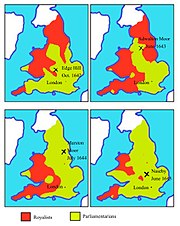
Cornwall played a significant role during the English Civil War, as it was a Royalist enclave in the generally Parliamentarian south-west. The reason for this was that Cornwall's rights and privileges were tied up with the royal Duchy and Stannaries and so the Cornish saw the King as protector of their rights and Ducal privileges. The strong local Cornish identity also meant the Cornish would resist any meddling in their affairs by any outsiders. The English Parliament wanted to reduce royal power. Parliamentary forces invaded Cornwall three times and burned the Duchy archives. In 1645 Cornish Royalist leader Sir Richard Grenville, 1st Baronet made Launceston his base and he stationed Cornish troops along the River Tamar and issued them with instructions to keep "all foreign troops out of Cornwall". Grenville tried to use "Cornish particularist sentiment" to muster support for the Royalist cause and put a plan to the Prince which would, if implemented, have created a semi-independent Cornwall.[37][38][39][40]
18th and 19th centuries

1755 Tsunami
On 1 November 1755 at 09:40 the Lisbon earthquake caused a tsunami to strike the Cornish coast at around 14:00. The epicentre was approximately 250 miles (400 km) off Cape St Vincent on the Portuguese coast, over 1,000 miles (1,600 km) south west of the Lizard. At St Michael's Mount, the sea rose suddenly and then retired, ten minutes later it rose 6 ft (1.8 m) feet very rapidly, then ebbed equally rapidly, and continued to rise and fall for five hours. The sea rose 8 ft (2.4 m) in Penzance and 10 ft (3.0 m) at Newlyn. The same effect was reported at St Ives and Hayle. The 18th century French writer, Arnold Boscowitz, claimed that "great loss of life and property occurred upon the coasts of Cornwall".[41]
Developments in tin mining

At one time the Cornish were the world's foremost experts of mining (See Mining in Cornwall and Devon ) and a School of Mines was established in 1888. As Cornwall's reserves of tin began to be exhausted, many Cornishmen emigrated to places such as the Americas, Australia, New Zealand and South Africa where their skills were in demand. There is no current tin mining undertaken in Cornwall, however a popular legend says that wherever you may go in the world, if you see a hole in the ground, you'll find a Cornishman at the bottom of it [citation needed]. Several Cornish mining words are in use in English language mining terminology, such as costean, gunnies, and vug.
Since the decline of tin mining, agriculture and fishing, the area's economy has become increasingly dependent on tourism— some of Britain's most spectacular coastal scenery can be found here. However Cornwall is one of the poorest parts of Western Europe and it has been granted Objective 1 status by the EU.
Politics, religion and administration
Cornwall and Devon were the site of a Jacobite rebellion in 1715 led by James Paynter of St. Columb. This coincided with the larger and better-known "Fifteen Rebellion" which took place in Scotland and the north of England. However the Cornish uprising was quickly quashed by the authorities. James Paynter was tried for High Treason but claiming his right as a Cornish tinner was tried in front of a jury of other Cornish tinners and was cleared.
Industrialised communities have long appeared to weaken the pre-eminence of the Church of England, and as the Cornish people were readily involved in mining, a rift developed between the Cornish people and their Anglican clergy in the early 18th-century.[42] Resisting the established church, many ordinary Cornish people were Roman Catholic or non-religious until the late 18th century, when Methodism was introduced to Cornwall during a series of visits by John and Charles Wesley. Methodist separation from the Church of England was made formal in 1795.
In 1841 there were ten hundreds of Cornwall: Stratton, Lesnewth and Trigg; East and West; Powder; Pydar; Kerrier; Penwith; and Scilly. The shire suffix has been attached to several of these, notably: the first three formed Triggshire; East and West appear to be divisions of Wivelshire; Powdershire and Pydarshire. The old names of Kerrier and Penwith have been re-used for modern local government districts. The ecclesiastical division within Cornwall into rural deaneries used versions of the same names though the areas did not correspond exactly: Trigg Major, Trigg Minor, East Wivelshire, West Wivelshire, Powder, Pydar, Kerrier and Penwith were all deaneries of the Diocese of Exeter but boundaries were altered in 1875 when five more deaneries were created (from December 1876 all in the Diocese of Truro).[43]
20th and 21st centuries
A revival of interest in Cornish studies began in the early 20th century with the work of Henry Jenner and the building of links with the other five Celtic nations.
A political party, Mebyon Kernow, was formed in 1951 to attempt to serve the interests of Cornwall and to support greater self-government for the county. The party has had elected a number of members to county, district, town and parish councils but has had no national success, although the more widespread use of the Flag of St Piran has been accredited to this party.[citation needed]
Recently there have been some developments in the recognition of Cornish identity or ethnicity. In 2001 for the first time in the UK the inhabitants of Cornwall could record their ethnicity as Cornish on the national census, and in 2004 the schools census in Cornwall carried a Cornish option as a subdivision of white British.
See also
- History of the British Isles
- Timeline of Cornish history
- Constitutional status of Cornwall
- List of Cornish soldiers, commanders and sailors
Notes
- ^ Hencken, H. O'Neill (1932) The Archaeology of Cornwall and Scilly. London: Methuen.
- ^ Pevsner, Nikolaus (1970). Cornwall. "Introduction: Prehistory," pp. 25-29. Penguin Books
- ^ a b c d Philip Payton. (1996). Cornwall: A History. Fowey: Alexander Associates
- ^ Halliday, F. E. (1959) A History of Cornwall. London: Duckworth ISBN 1-84232-123-4, p. 51.
- ^ Halliday, p.52.
- ^ Kendrick, Thomas D. (1950). British antiquity. London: Methuen & Co. BNBNo.b5007301. pp. 107, 132
- ^ Penhallurick, Roger D. (1986). Tin in antiquity: its mining and trade throughout the ancient world with particular reference to Cornwall. London: The Institute of Metals. ISBN 0-904357-81-3. pp.123-131 (Chapter 21 "The Phoenician myth")
- ^ Gerrard, Sandy (2000). The early British tin industry. Stroud, Glos: Tempus Publishing. ISBN 0-7524-1452-6. p. 21.
- ^ Cornwall Council history page.
- ^ Cornwall County Council, Overview Of Cornish History.
- ^ Roman Fort Discovered - Were The Romans Using Cornish Silver?
- ^ Roman-British Villa Magor Farm, Illogan, Redruth, Cornwall.
- ^ Roman Milestones near Nanstallon The Trethevy stone can be dated ca. 252 as both Caesars died in the following year.
- ^ Fleuriot, Léon (1982) Les Origines de la Bretagne. Paris: Payot; p. 18
- ^ http://www.historic-cornwall.org.uk/flyingpast/continuity.html#courtyard
- ^ a b Excavations at Tintagel Castle, Cornwall, 1990-1999, R Barrowman, C Batey, C Morris, Society of Antiquities,London 2007
- ^ The Mabinogion, Translated Sion Davies, Oxford University Press, 2007
- ^ David Dumville: Britons and Anglo Saxons in the Early Middle Ages : The West Saxon Genealogical Regnal List and the chronology of Wessex [1977]
- ^ Ibid.
- ^ La Bretagne; des origines a nos jours; Bernard Medrignac, Editions Ouest France, 2009
- ^ a b c Anglo-Saxon Chronicle.
- ^ Halliday, p.102.
- ^ a b Keynes, Simon; Lapidge, Michael (tr.) (1983), Alfred the Great - Asser's Life of King Alfred and other contemporary sources, London, Penguin Books; p. 175; cf. ibid, p89.
- ^ Wood, Michael (1986) Domesday: a search for the roots of England. London: Guild Publishing; p.188.
- ^ a b Todd, Malcolm (1987) The South West to AD 1000, pp. 287–9.
- ^ Williams, Ann; Martin, G. H. (tr.) (2002) Domesday Book: a complete translation, London, Penguin Books, pp. 341-357
- ^ Swanton, Michael (tr.) (2000), The Anglo-Saxon Chronicles, 2nd ed. London: Phoenix Press, p. 177
- ^ Camden, William (1607). "Britannia".
- ^ http://www.historic-cornwall.org.uk/flyingpast/medieval.html
- ^ Medieval Devon and Cornwall, Shapind an Ancient Countryside, Ed Sam Turner, 2006 Windgather Press
- ^ Shepherd, William R. (1911) Historical Atlas. "Dominions of Cnut".
- ^ Anglo-Saxon Chronicle (2000), p.177. The Old English word translated by Swanton as "Cornwall" is "Wealas", which some translations render as "Wales". However, in the Anglo-Saxon period this terminology was applied equally to all Brythonic people and their lands, not specifically to Wales and the Welsh in the modern sense. Since this reference concerns a parcel of adjoining territories contiguous with Cornwall but not with Wales, and since Wales was not under English rule at this date whereas the evidence of Domesday Book indicates that Cornwall was, it may reasonably be concluded that the land in question was "West Wales" (i.e. Cornwall), not "North Wales".
- ^ Williams, Ann and Martin, G. H. (tr.) (2002) Domesday Book: a complete translation, London: Penguin, pp. 341-357.
- ^ Domesday Book, tr. Williams and Martin, pp. 341-357.
- ^ Davies, Norman. The Isles: A History. Macmillan. p. 497. ISBN 978-0-333-69283-7.
- ^ Rwose, A. L. (1941) Tudor Cornwall. London: Cape.
- ^ Stoyle, Mark (2002). West Britons. University of Exeter Press
- ^ Burne, A. H. & Young, Peter (1959) The Great Civil War, a military history.
- ^ Gardiner, S. R. (1888) History of the Great Civil War vol. i.
- ^ Gaunt, Peter (1987) The Cromwellian Gazetteer
- ^ Cornwall Council. Sources of Cornish History - The Lisbon Earthquake
- ^ Cornwall County Council - Cornish Methodism
- ^ Cornish Church Guide (1925). Truro: Blackford
References
Constructs such as ibid., loc. cit. and idem are discouraged by Wikipedia's style guide for footnotes, as they are easily broken. Please improve this article by replacing them with named references (quick guide), or an abbreviated title. (March 2013) |
- Anglo-Saxon Chronicle, tr. Michael Swanton (2000), 2nd ed., London, Phoenix Press. An online translation is also available at the Avalon Project.
- Cornwall Council Home Page.
- Halliday, F.E, A History of Cornwall, Duckworth, 1959, ISBN 1-84232-123-4 and Halliday, Frank Ernest (2001). History of Cornwall, 2nd edition. Main text same as 1959 edition but with afterword by Halliday's son. Thirsk, North Yorkshire: House of Stratus. ISBN 0-7551-0817-5.
- Payton, Philip (1996) Cornwall; Fowey: Alexander Associates ISBN 1-899526-60-9. Revised edition Cornwall : a history, Fowey: Cornwall Editions Ltd, 2004 ISBN 1-904880-00-2 (Available online on Google Books).
- Rowse, A. L. (1941) Tudor Cornwall. London: Jonathan Cape
Further reading

- Blight, John Thomas (1872) Ancient Crosses and Other Antiquities in the East of Cornwall 3rd ed. (1872)
- Blight, John Thomas (1856) Ancient Crosses and Other Antiquities in the West of Cornwall (1856), 2nd edition 1858. (A reprint is offered online at Men-an-Tol Studios) (3rd ed. Penzance: W. Cornish, 1872) (facsimile ed. reproducing 1856 ed.: Blight's Cornish Crosses; Penzance : Oakmagic Publications, 1997)
- Elliott-Binns, Leonard Elliott (1955) Medieval Cornwall. London: Methuen & Co
- Wood, Michael (1981). In Search of the Dark Ages. BBC. ISBN 0-563-17835-3. with several subsequent editions and reprints.
| History of England |
|---|
 |
|
|
